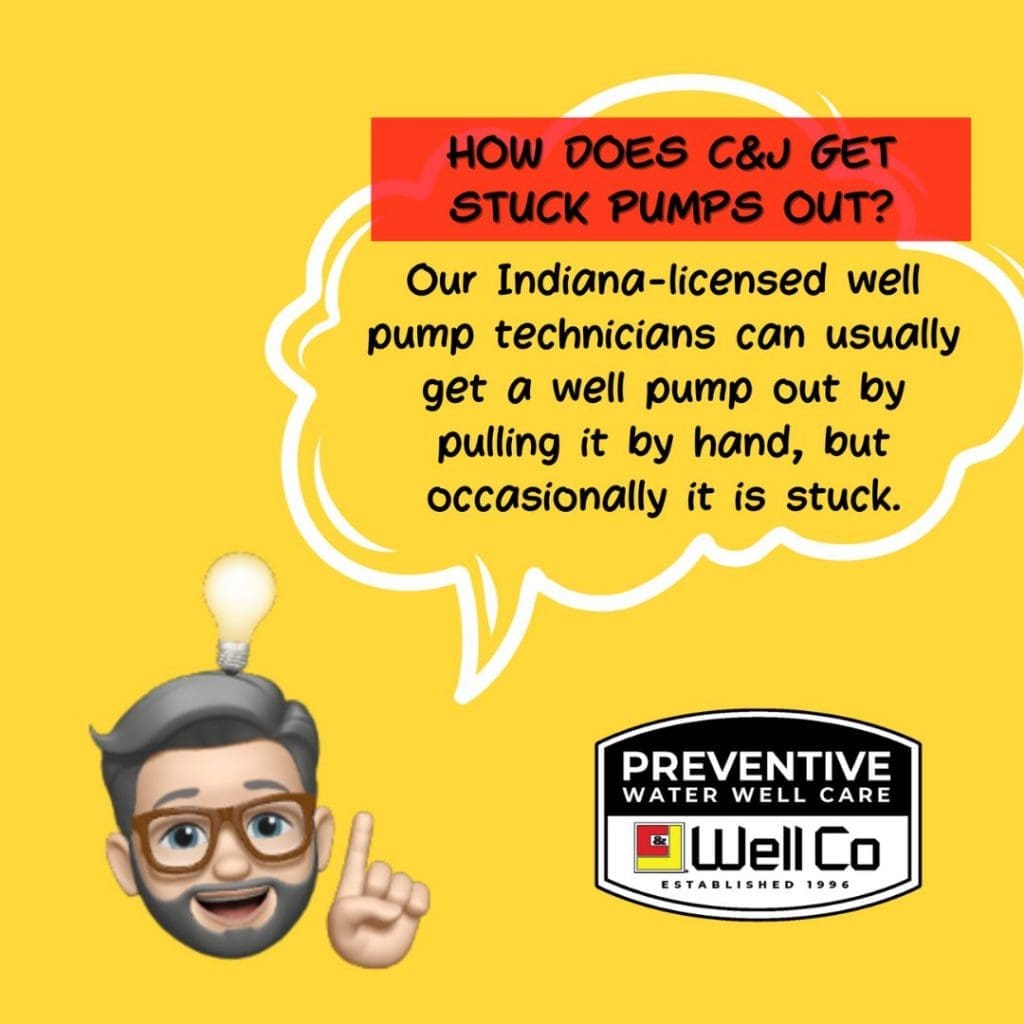It’s not as trippy as you might think.
Occasionally the well pump is stuck inside the casing when we service a well. Well pumps get stuck when the iron in the water oxidizes, forming rust. Over the years, this rust has built up in the metal well casing and doesn’t allow enough room for your pump to be removed and serviced. Although C&J has all the equipment and procedures to pull your pump out and complete the service, this extra process can be expensive and time-consuming. The best solution is to prevent it from ever happening in the first place. This post will explore how water well pumps get stuck inside the casing, what C&J can do to get them out, and what homeowners can do to prevent their pumps from getting stuck in the first place.
How do well pumps work?
First, let’s remind ourselves what a submersible well pump is and does. A submersible pump is a water pump that has to be submerged underwater to work. Usually, submersible well pumps sit between 50 and 300 feet below the ground. Pumps are not intended to run continuously and don’t start each time you open a tap or flush the toilet. To provide consistent water pressure at the fixtures, the pump first moves water to a storage tank (in a traditional well system). Inside a modern tank is an air bladder that becomes compressed as the water is pumped in. The pressure in the tank moves the water through the household plumbing system. A switch stops the pump when the pressure reaches a preset level, which can be anywhere from 40 to 60 psi. As water is used in the home, pressure begins to decrease until, after a drop of about 20 psi, the switch turns on the pump, and the cycle is repeated. You’ll find the pressure gauge mounted on the tank with wires leading to the switch that controls the pump. The pressure tank acts as a “reservoir” and allows water to be drawn from the tank without the pump turning on and off each time the water is turned on. This process protects the pump and extends its life. A pressure tank also cuts back on instances of “water-hammer,” reduces air in the pipes, and controls the pressure in your water system.
What Causes Well Pumps to Get Stuck?

As mentioned above, water well pumps get stuck when the iron in the water oxidizes, forming rust. As the water ebbs and flows inside the casing, it causes the iron in the water to be exposed to air. When iron is exposed to moisture or oxygen, oxidation occurs. During this chemical reaction, iron is converted into iron oxide. The iron oxide typically has a reddish, flaky appearance that worsens progressively over time. Iron can rust from either exposure to air or exposure to moisture. Both oxygen and moisture are catalysts for rusting. When iron is exposed to air or moisture, oxidation will convert it into iron oxide.
Also, if the pump isn’t removed periodically for routine preventive maintenance, naturally occurring minerals bond the pump motor to the steel well casing. Once this bonding occurs, it is very difficult to remove the well pump. Furthermore, if your well casing is 3”, you need to pay particular attention to the oxidization process, as there isn’t much room for error.
How Does C&J Get Stuck Pumps Out?

Our Indiana-licensed well pump technicians can usually get a well pump out by pulling it by hand, but occasionally it is stuck. If the pump sticks, we use muriatic acid to break down the mineral ring causing the motor to adhere to the well casing. Muriatic acid is one of the names for hydrochloric acid—a strong corrosive acid. It is also known as spirits of salt or acidum salis. The name muriatic acid is derived from the Latin word muriaticus, which means “pickled in brine” because it’s used as a pickling agent to remove oxides from the surface of metals.
Once the acid is applied, we continue to work the pump out by hand and more acid until we can no longer proceed or it comes out. If the pump no longer moves, we usually use a hoist truck to either get it out or break it off. If the well pump doesn’t come up and out during these processes, it could be necessary to drill a new well or hook up to the municipal source, if available.
What Can Homeowners Do to Prevent Their Pump from Getting Stuck?
It is best to avoid a stuck pump situation in the first place through preventive maintenance. What are the preventive measures you should take? The primary and most important step is a well cleaning every ten years. During a well cleaning, we remove your submersible pump from the well, lower a high-output airline into the well, and airlift years of built-up sediment and gunk through the top of the well. This freshens up your old well and redevelops the well screen, giving you better flow and quality water.
Also, keep an eye out for low water pressure, poor water taste or smell, or sediment and other contaminants in your water. These signs could portend larger issues with your water well system.
When was the last time you had your well cleaned? If it’s been a while or you can’t remember, now is a perfect time to schedule. This Autumn, C&J is offering a special deal for preventive maintenance—the $1250 well cleanout mentioned above is now only $995. This well cleanout includes a 6-point inspection of your well system—bacteria testing, flow evaluation, analysis of your pressure switch and tank, an exam of your visible piping, and testing for appropriate amps/ohms. Fall is the season for preventive maintenance, so contact us today to schedule!









